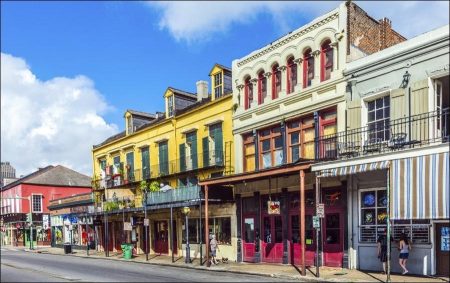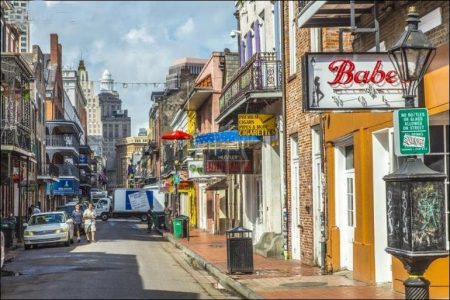After American annexation numerous Americans, aware of the fortunes to be made in a city so advantageously situated, began to settle in New Orleans. Because of the antipathy of the Creoles, who pictured all Americans as boorish rowdies, the newcomers settled in the Faubourg Ste. Marie on the upstream side of the town in what is now the business section of New Orleans.
Here they developed a town quite distinct from the old New Orleans. As time passed and the city began to benefit from unrestricted trade with other States of the Mississippi Valley the two elements merged, and though the Creoles held themselves aloof socially, common civic interests and the leveling effect of commercial intercourse tended to unite the inhabitants.
New Orleans was incorporated February 17, 1805, and the city limits defined. The municipal government consisted of a mayor, a recorder, a treasurer, and fourteen aldermen. The latter formed a council whose function it was ‘to make and pass all by-laws and ordinances for the better government of the affairs of the city corporation.’ Free white males, residents of New Orleans for a year, either owners of real estate of five hundred dollars’ value or renters paying one hundred dollars a year, were qualified to vote. James Pitot, builder of one of the first cotton presses in New Orleans (corner of Toulouse and Burgundy Streets) succeeded Étienne de Boré as mayor, and on March 4, 1805, the townspeople first exercised their franchise in an election of aldermen.
In the same year the Legislature provided for the establishment of New Orleans’first higher institution of learning, the College of Orleans. Schools in the Colony had been scarce. The Ursuline nuns offered instructions to seventy or eighty young girls and maintained a schoolhouse near the convent where ‘female children appeared at certain hours to be gratuitously instructed in writing, reading, and arithmetic.’
No mention is made of similar schools for boys; they had to rely, possibly, upon private schools such as that conducted by the Reverend Philander Chase on Tchoupitoulas Street, or that opened at 29 Bienville Street by Francis Hacket, teacher of English, arithmetic, geography, and history. The College of Orleans, which was finally opened in 1811 through a government appropriation of $15,000, had a president and four professors and a curriculum which included Latin, Greek, English, French, Spanish, philosophy, literature, and the sciences. From 1822 to 1825 the college was under the direction of Joseph Lakanal, prominent for his work in reorganizing the French school system under the Directory and Napoleon.
The New Orleans Library Society was incorporated April 19, 1805, when an unlimited number of twenty-five-dollar shares were sold and the first library in New Orleans was established. During the same year, after a vote of the Protestants in the city favored an Episcopal clergyman, the first Protestant church was organized.
Many improvements were made in the town during the next few years. A waterworks carrying water from the Mississippi in wooden conduits laid a foot and a half below the banquettes was installed by Louis Gleise; a Negro chain gang was employed in filling in the streets; sidewalks were built and crossing bridges constructed; and meat markets, notoriously unclean, had their water closets torn down.
As the center of Aaron Burr’s filibustering schemes, New Orleans was thrown into a panic in the winter of 1806 when a large flotilla with Burr as its leader was reported descending the Mississippi to use the city as a base in furthering his intention of separating the Western country from the United States or, failing in that, to wrest Mexico from Spain. The banks were to be plundered of $2,000,000 and Louisiana revolutionized.
Great efforts were made to fortify the city against what was said to be a formidable force. The Chamber of Commerce met to consider ways and means of defense, money was subscribed, orders given for organization of the Battalion of Orleans, and volunteers and the militia cavalry ordered out. In the meantime, Burr with sixty to eighty men kept ahead of orders for his arrest until he was stopped at Natchez and held for trial, at news of which the hysteria in New Orleans subsided as quickly as it had been aroused.
The first steamboat to descend the Mississippi River arrived in New Orleans amid great enthusiasm on January 10, 1812. Propulsion by steam solved the problem of upstream navigation, and was the greatest single factor in the rapid growth of New Orleans to a major North American port.
Louisiana was admitted to the Union April 30, 1812. New Orleans, then the capital of the State, had a population of 24,552 in 1810, having more than doubled its population in the first decade of the nineteenth century. This increase was caused largely by the immigration of refugees from Santo Domingo; almost six thousand arrived in two months in 1809. The city, hard pressed at first to find room for the immigrants, absorbed them in the course of time. Gay and luxury-loving, they infused a new spirit into the town and tended to offset the American influence then beginning to be felt.
Visits: 114




